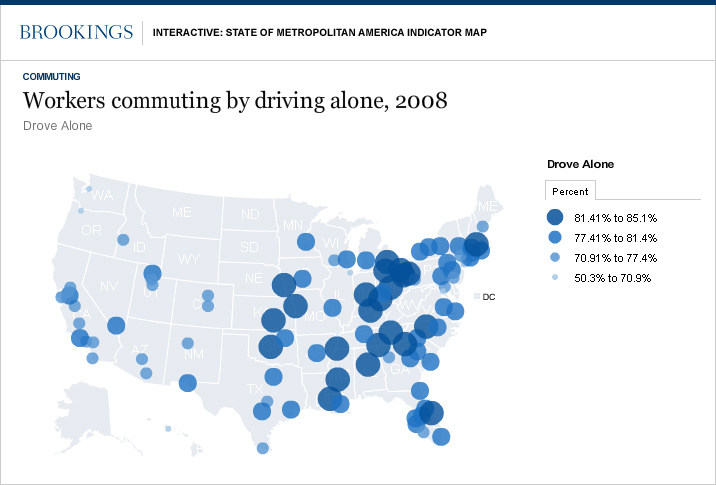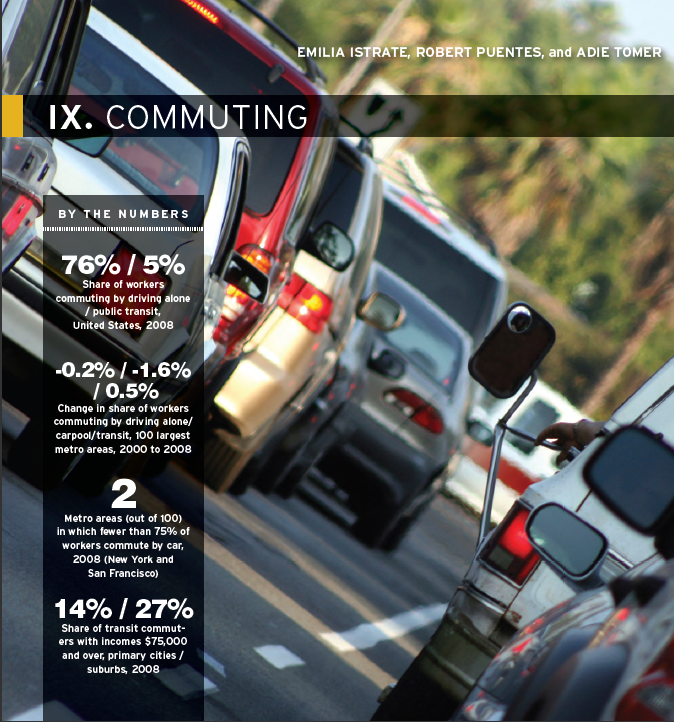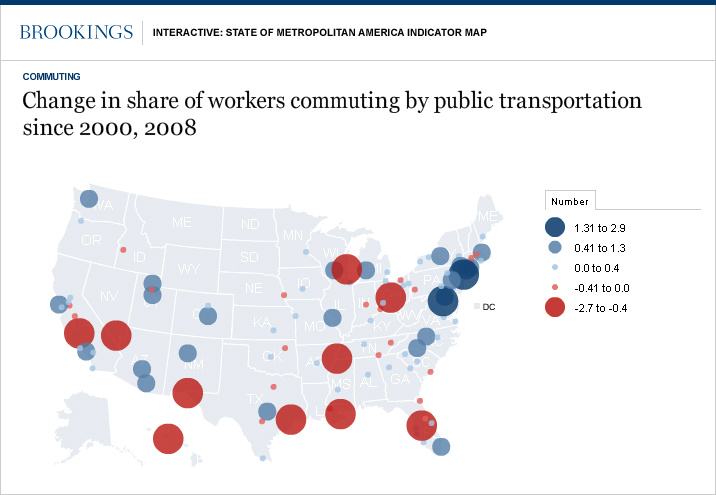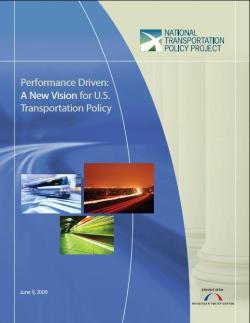The Brookings Inst. report uncovers America’s shifting commuting choices
(Source: Brookings Institution; The New Republic)
The comprehensive report The State of Metropolitan America is a signature effort by Brookings Metropolitan Policy Program portrays the demographic and social trends shaping the nation’s essential economic and societal units—its large metropolitan areas—and discusses what they imply for public policies to secure prosperity for these places and their populations.
The report shows that while Americas still drive to work alone in far greater numbers than any other way, the share of Americans that commute by transit actually increased from 2000 to 2008. That’s the first time that’s happened in 40 years. The map shows that part of the increase is due to big gains metropolitan areas with large transit systems and extensive rail networks such as New York and Washington.
Here is a compilation of the report’s findings on “commuting”:
- Reversing a pair of 40-year trends, the share of Americans that commute by transit increased from 2000 to 2008, while the share of those that drive alone to work fell slightly. However, driving alone remains the method by which fully three-quarters of Americans get to work. Transit usage increased among whites and Asians, while carpooling dropped significantly among blacks and Hispanics.
- Regional differences distinguish metropolitan commuting modes. Commuters drive alone to work in high proportions in mid-sized Midwestern and Southern metro areas like Youngstown and Baton Rouge. Carpooling is most popular in Southern and Western metro areas, including many with large Hispanic populations like Bakersfield and McAllen. Public transit commuting is concentrated in the nine large metro areas that have rates above the metropolitan average (7 percent), including New York, San Francisco, Washington, and Boston.
- Metropolitan areas with large transit systems were not alone in seeing increased transit usage during the 2000s. While metropolitan areas such as New York and Washington with extensive rail networks saw the largest increases in the share of commuters using transit, metro areas that opened light rail lines this decade such as Charlotte and Phoenix saw upticks as well. Others that rely almost exclusively on buses for transit commuting (Colorado Springs, Albuquerque, and Seattle) also experienced notable increases.
- In only 19 of the 100 largest metro areas did more than a quarter of the workforce in 2008 commute by a mode other than driving alone. In only two of those metropolitan areas (New York and San Francisco) did more than a quarter of workers commute other than by car. Carpooling is an important alternative to driving alone in both mid-sized (Honolulu, Stockton) and large (Los Angeles, Seattle) metro areas.
- Residents of cities and older, high-density suburbs are more likely to use transit than commuters elsewhere in metro areas. Suburban transit users have higher incomes than both city transit users and suburbanites overall. Rates of working at home are roughly the same across cities and all types of suburbs, though more common among higher educated workers.
Rob Puentes, one of the authors of this report, observes in his article on the New Republic: It is important to note that while two-third of metros saw increases in commuting by transit during the 2000s, most of these increases were very small. Only four were more than 1 percent and important places like Houston, Memphis, Las Vegas, and Milwaukee saw transit drops. But at the same time, the only decrease in transit use larger than 1 percent was in the New Orleans metro area, due to the aftermath of Hurricane Katrina.

Click here to access the entire report.
Related articles by Zemanta
- Two New Studies on Density and Driving (worldchanging.com)
- Bus cuts drive Americans back to cars | Sasha Abramsky (guardian.co.uk)
- Taking Public Transit Might Help You Stay Slim (nlm.nih.gov)






